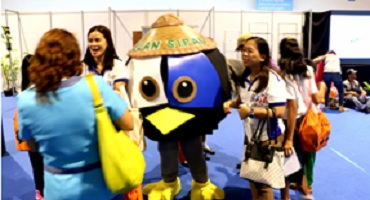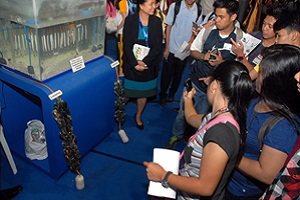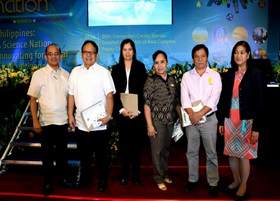 The Philippine Council for Agriculture, Aquatic and Natural Resources Research and Development of the Department of Science and Technology (DOST-PCAARRD) once more made publicly known the fruits of its research and development activities as it joined the National Science and Technology Week through exhibits and fora recently.
The Philippine Council for Agriculture, Aquatic and Natural Resources Research and Development of the Department of Science and Technology (DOST-PCAARRD) once more made publicly known the fruits of its research and development activities as it joined the National Science and Technology Week through exhibits and fora recently.
Presented in meticulously designed centerpiece and four elaborately conceptualized pavilions, (crops, livestock, aquatic, and forestry and environment) the PCAARRD exhibit articulated the Council’s research and development stance in response to Outcome One as it adopted the theme SIPAG ni Juan.
SIPAG ni Juan reflects PCAARRD and its partners’ effort to vigorously pursue the Council’s Strategic Industry S&T Program for Agricultural Growth (SIPAG). The tagline also denotes hard work and dedication as it applies to agricultural endeavors which are enriched by science and technology interventions.
The country’s proverbial Juan Tamad, a mythical character known among Filipinos for his extra ordinary indolence, takes a new vent as he was personified in the opposite by DOST Smarty’s Juan SIPAG.
Outcome One, as the frontrunner of the DOST’s eight major Outcomes, tasks PCAARRD to provide science-based know-how and tools that will enable the agricultural sector to raise productivity to world-class standards. Designed to usher in the flow of worthwhile and productive technologies, the pavilions embodied PCAARRD’s commitment in providing its share towards achieving economic development by raising agricultural productivity, improving product quality, lowering cost of production, and strengthening rural-based enterprises.
Designed to usher in the flow of worthwhile and productive technologies, the pavilions embodied PCAARRD’s commitment in providing its share towards achieving economic development by raising agricultural productivity, improving product quality, lowering cost of production, and strengthening rural-based enterprises.
The aquatic pavilion featured S&T-based products and tools developed to enable the aquatic sector to increase production efficiency and improve quality. Technologies on mud crab, shrimp, mussel, milkfish, oyster, and aquafeed were featured in this pavilion.
The forest and environment pavilion showcased technologies for producing quality planting materials and managing plantations to increase yield and farmers’ income. It featured S&T tools essential for decision support systems to promote climate-smart and resilient communities and ecosystems. Specifically, technologies for rubber, cacao, bamboo, industrial tree plantation, ferns, organic pesticides, and biodiversity information system were highlighted.
The crops pavilion, on the other hand, showcased S&T-based information, products, and technologies developed to attain crop productivity and improved product quality following global standards. Banana, coconut, mango, plant growth promoters, peanut, coffee, biotech-derived tools, rice, biofertilizer, and abaca technologies were featured in the crops pavilion.
Finally, the livestock pavilion featured S&T-based technologies for the livestock and poultry sectors to raise farm productivity and build rural assets. The livestock pavilion featured technologies on halal goat, swine, duck, native chicken, and feed resources.
Gracing the PCAARRD Exhibits and Agri-Aqua Forum were Senator Cynthia A. Villar, Chair, Senate Committee on Agriculture and Food and Secretary Francis N. Pangilinan of the Office of the Presidential Assistant for Food Security and Agricultural Modernization, who served as forum’s keynote speaker for the topic Coping with Cocolisap.  Geared towards achieving inclusive growth as part of the government’s social contract, the Agri-Aqua forum proved to be audience friendly in terms of simplifying technical jargons and in providing informative and well-rounded presentation of technologies. It made use of inspiring and inviting plain folk catch phrases such as Talaba Talaga, Sa Alimango Kikita Tayo, Abakada ng Abaca, and Halaman at Gulay pa More.
Geared towards achieving inclusive growth as part of the government’s social contract, the Agri-Aqua forum proved to be audience friendly in terms of simplifying technical jargons and in providing informative and well-rounded presentation of technologies. It made use of inspiring and inviting plain folk catch phrases such as Talaba Talaga, Sa Alimango Kikita Tayo, Abakada ng Abaca, and Halaman at Gulay pa More.
Other concerns covered during the forum included the Benham Rise Exploration and the government’s recent initiatives in addressing the coconut scale insect or cocolisap.
The Benham Rise exploration is a research project initiated to assess the benthic marine biological features and resources of the Benham Bank situated at the Benham Rise Region. This region was acquired as a new territory of the Philippines based on the country’s submission for Benham Rise to be considered as an extended continental shelf of the country. The submission was adopted in full by the Commission on the Limits of the Continental Shelf of the United Nations on April 12, 2014.
The research exploration is a collaboration of UP Mindanao, UP Baguio, Xavier University and Ateneo de Manila University.
As one of the most pressing concerns in agriculture, the issue on coconut scale insect again took center stage in the afternoon of the third day of the NSTW in a forum dubbed as Coping with Cocolisap. The forum provided information on the government’s recent initiatives on coconut scale insect (CSI) and the venue for stronger collaboration among concerned agencies.
Recognizing the indispensable partnership between the science and technology sector and the education sector as two potent and inseparable elements of development, PCAARRD once more sponsored a poster painting contest for high school students. The contest gathered students from various schools in Metro Manila, Laguna and Rizal.
